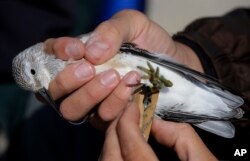Billions of species make migratory journeys every year. They travel by land, the oceans, the sky. Their journeys are legend. Children learn about them in schools. Some people are lucky enough to witness portions of some of the extraordinary annual trips the animals take to feed and to breed.
But now, according to a landmark U.N. report, released Monday in Samarkand, Uzbekistan, all that is under threat.
The two largest threats to all migratory species? Overexploitation and habitat loss due to human activity.
Inger Andersen, head of the U.N.’s Environment Program said, “Today’s report sets out the evidence that unsustainable human activities are jeopardizing the future of migratory species.”
The report by the Convention of the Conservation of Migratory Species of Wild Animals, or CMS, found that nearly half of the migratory species under international protection are in decline, with 22% threatened with extinction.
“The extinction risk is growing for migratory species globally,” the report said, “including those not listed under CMS.”
Climate change is also listed as a threat to the animals, as are pollution and invasive species.
The main focus of the report was the 1,189 species recognized by CMS as needing international protection.
All CMS fish species had a high rate of extinction, the report said, with a 90% decline rate since the 1970s.
The CMS found 399 migratory species that are not under international protection, most of them fish and birds, that have been listed as threatened or near-threatened.
CMS chief Amy Fraenkel told Agence France-Presse, “We are finding out the phenomenon of migration itself is under threat.” She said the report should be a “wake up call about what’s happening.”






